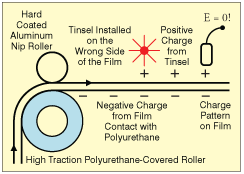How To Use an Electrostatic Voltmeter
- Published: May 01, 2010, By By Dr. Kelly Robinson Contributing Editor

This month, I am delighted to celebrate the one-year anniversary of “Static Beat,” which first appeared in the May 2009 issue of PFFC. For many, static electricity is a mystery. From my perspective, electrostatics is a fascinating and interesting topic that is governed by the fundamental principles of physics and engineering. Once these principles are clearly understood, static problems become just like the many other technical problems that skilled technologists, scientists, and engineers solve every day by taking meaningful measurements, analyzing the results, and applying the fundamental principles. I invite you to send me your questions on static control and to suggest topics for future columns.
Measuring static is important so we can understand the problem, identify possible solutions, and assess the feasibility and effectiveness of our alternatives. There are at least three different types of instruments that we can use to measure static: an electrostatic fieldmeter, the workhorse for diagnosing static problems; a Coulomb meter, which measures charge on objects or film samples that fit within a Faraday cup; and a non-contacting electrostatic voltmeter, which measures the surface potential of a film.
An electrostatic fieldmeter responds to the total amount of charge on a film. A Coulomb meter is the only one of these three instruments that directly measures the total amount of charge on an object small enough to fit within the Faraday cup. Both of these instruments respond to the total or net charge on the film. Neither can reveal information about the distribution of charge or where the charge is located on the film.

Having an instrument that responds only to the charge on one surface of the film is very important. For example, Figure 1 shows a high-traction polyurethane-covered roller used to isolate the tension in a film conveyance path. An aluminum hard-coated nip roller holds the film firmly against the polymer-covered roller. Nip rollers are common at the exit of the dryer in coating operations and just prior to the chopper in sheeters.
To control static on the film in Figure 1, tinsel is installed above the film just downstream of the nip roller. However, this tinsel is on the wrong side of the film, and instead of neutralizing the charged film, the tinsel generates a very common pattern of charge in which one surface has positive charge and the other surface has an equal amount of negative charge.

The electrostatic fieldmeter in Figure 1 will read zero electric field because the net charge on the film is zero. However, sheets cut from this film will have static cling problems caused by charge from the polyurethane roller.
This static charge is best measured using a non-contacting electrostatic voltmeter as shown in Figure 2. For example, 50-µm-thick polymer film (κFILM ≈ 2.5) with surface charge density of 1 µC/m2 is wrapped on a metal roller that is at ground potential. The voltmeter detects the surface potential given in Equation 1 of about 2 volts. This modest voltage is caused by a charge density that is sufficient to cause significant static problems on a winding stockroll or in a sheeting operation.
Electrostatic fieldmeters are the workhorse instruments used in industrial applications to solve static problems. However, fieldmeters respond only to the total or net charge on a film and provide no information on the distribution of the charge. Non-contacting electrostatic voltmeters are a valuable complement to fieldmeters because voltmeters respond to the charge present on only one side of the film.
Equation 1. VSURFACE = σSURFACE dFILM / κFILM ε0 = (1 µC/m2)
(50 µm)/(2.5)(8.854 pF/m) ≅ 2.2 volts
Static control expert Dr. Kelly Robinson, president of Electrostatic Answers, has 27+ years of experience in problem-solving and consulting. Contact him at 585-425-8158; This email address is being protected from spambots. You need JavaScript enabled to view it.; www.electrostaticanswers.com.




